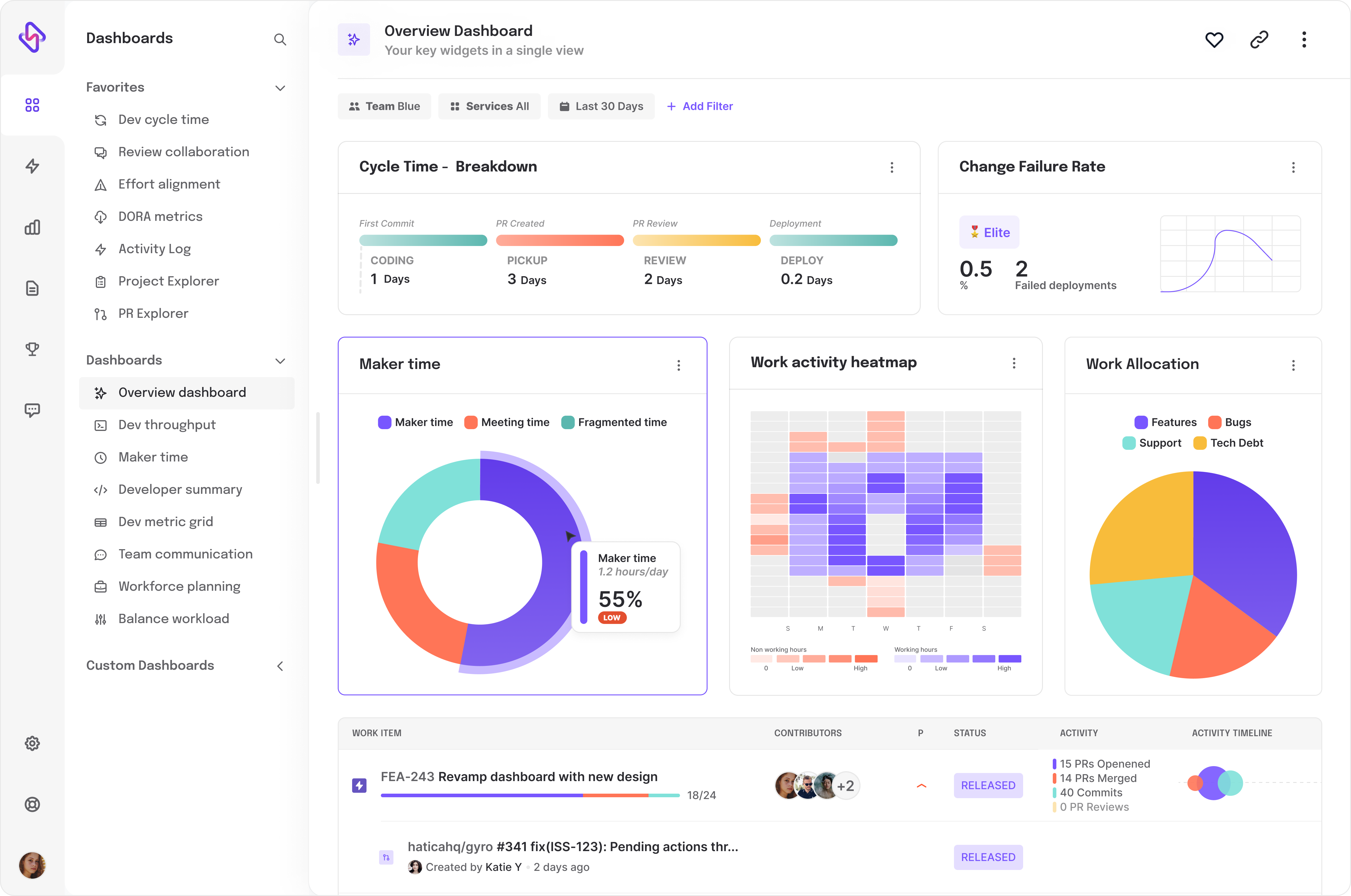Sprint planning is an essential part of Agile project management, providing engineering teams with a structured roadmap for each sprint. Done right, it aligns the team, establishes clear priorities, and sets achievable goals, helping teams deliver high-quality work, sprint after sprint. This guide covers everything you need to know about sprint planning—from preparation, execution and to overcoming common challenges.
What is Sprint Planning?
Sprint planning is the first step in every sprint cycle. This Sprint planning meeting brings the engineering team together to discuss, prioritize, and commit to tasks for the upcoming sprint. It goes beyond just task allocation as it’s a collaborative session where goals are clarified, tasks are broken down, and everyone is aligned on what they aim to achieve. At its core, sprint helps engineering teams maintain a steady pace of delivering value.
In a typical sprint planning session, the engineering team reviews the backlog, identifies priority tasks, and decides on a clear sprint goal. This goal serves as the north star for the sprint, guiding every action and decision the team makes. With an effective sprint plan, teams can focus on delivering consistent results while staying adaptable to new challenges and insights.
What are The Four Phases of Sprint Planning in Agile?
Sprint planning is not a one-time task; it’s a cycle that involves several key phases, each critical to keeping the engineering team aligned and ensuring continuous improvement. Let’s take a closer look at the four phases of a sprint to understand how each one contributes to successful sprint execution.
1. Planning
This phase is where the engineering team sets its sights on the sprint goal. But here’s a subtle yet powerful nuance: a sprint goal isn’t just a target—it’s a decision filter. Every task, adjustment, or trade-off should tie back to this goal.
When the engineering team is clear on what success looks like, they don’t just execute—they adapt with intent.
2. Execution
This seems pretty straightforward but sprint execution is not just limited to “getting things done.” It’s about maintaining momentum without losing sight of quality. Daily stand-ups are your lifeline here, but not for the reasons you might think.
Stand-ups aren’t just status updates; they’re calibration points. They reveal patterns, dependencies, and emerging risks, allowing the engineering team to pivot early instead of reacting late.
3. Review
The sprint review becomes a moment of accountability and alignment. Presenting work to stakeholders opens the door to feedback, but here’s the nuance: feedback isn’t just about finding faults; it’s about uncovering possibilities.
Encourage stakeholders to think critically about what’s next. A great sprint review doesn’t just reflect on progress—it sets the stage for opportunity.
4. Retrospective
Retrospectives are often treated as afterthoughts, but they’re the secret weapon of high-performing engineering teams. The real value of a retrospective lies not in identifying what went wrong but in uncovering why.
Here’s the thing: focus on systems, not symptoms. If a task took longer than expected, was it due to unclear requirements, unrealistic estimates, or misaligned priorities? The answers to these questions fuel meaningful change.
We discuss this in our more in-depth blog on Sprint Review vs. Sprint Retrospective
What is the Right Length for a Sprint?
While two-week sprints are standard for many agile teams, it’s essential to remember that the “right” length can vary depending on the team’s workload, objectives, and need for feedback.
Many engineering teams experiment with different sprint lengths—from one week to four weeks—to find what works best for their unique dynamics, workflows, and project requirements.
For some teams, shorter sprints (e.g., one week) create opportunities for rapid feedback and faster iterations. These frequent cycles work well for projects requiring quick adjustments and ongoing refinements. On the other hand, some teams prefer longer sprints (e.g., three or four weeks) when working on more complex or resource-intensive tasks. Longer sprints allow for deeper focus and fewer context switches, which can be beneficial when tackling large-scale projects.
In reality, the ideal sprint length is the one that supports your team’s pace without sacrificing quality. As your team grows and adapts to new projects, this length might shift, so staying open to adjustments is key.
How to Plan & Prepare for Sprint Planning?
Step 1: Have a Clear Leader at the Helm
Every ship needs a captain. A strong leader—often the Scrum Master or Product Owner—is essential for steering the sprint planning session with purpose. But here’s the nuance: a leader’s role isn’t to dictate but to facilitate. The best leaders ask questions that uncover blind spots, spark collaboration, and surface ideas that might otherwise remain buried.
A good leader keeps the engineering team focused, but a great one ensures every voice is heard, turning the plan into a collective roadmap rather than a one-sided directive.
Step 2: Keep Your To-Do List (Backlog) in the Best Shape
The backlog is your engineering team’s single source of truth, but it’s also the easiest place for chaos to take root. A cluttered backlog isn’t just a logistical issue—it’s a psychological one. It distracts, overwhelms, and dilutes focus.
Regular backlog grooming is non-negotiable. But here’s the insight: it’s not just about removing outdated tasks; it’s about ensuring each remaining task carries context. A well-groomed backlog tells a story, allowing your engineering team to prioritize with confidence instead of second-guessing intentions.
Step 3: Focus on What Matters Most: Functionality for the User
In sprint planning, it’s easy to get bogged down in technical details or internal dependencies. But here’s a truth worth reflecting on the most elegant code in the world is meaningless if it doesn’t serve the end user.
A user-centric approach to sprint planning isn’t just about shipping features; it’s about delivering outcomes. This mindset shifts the conversation from “What can we build?” to “What problem are we solving?”
And here’s the kicker: prioritizing functionality for the user doesn’t just lead to better products—it cultivates a sense of purpose within the engineering team.
Why is Sprint Planning Important?
Even the most meticulous sprint plans can be upended by the unexpected—a critical bug, an urgent stakeholder demand, or a surprise dependency. The real challenge isn’t the work itself; it’s how engineering teams react. Building flexibility into the sprint plan isn’t a sign of inefficiency—it’s a safeguard against the inevitable chaos of software development. Teams that resist this buffer often end up sacrificing long-term goals to extinguish short-term fires.
1. Realistic Commitments and Predictable Delivery
Sprint planning is about finding the sweet spot between ambition and capacity. The nuance here is acknowledging that predictability isn’t about doing everything—it’s about doing the right things consistently. Engineering teams that resist the urge to overcommit deliver not just on time but with trust and confidence intact.
2. Early Risk Identification and Course Correction
Sprint planning is where hidden complexities come to light. Spotting a dependency or a misaligned priority during planning might feel inconvenient, but it’s a gift compared to mid-sprint firefighting. The key insight? Every minute spent addressing risks upfront saves hours of disruption later.
3. Self-Organizing and Empowered Teams
Any empowerment isn’t granted in a sprint planning session—it’s cultivated. When engineers actively shape the sprint, they aren’t just aligning with the plan; they’re owning it. This shift from "task-taker" to "decision-maker" fosters accountability and transforms execution into a team-driven process.
4. Improved Project Delivery
Sprint planning isn’t a silver bullet, but it’s a stabilizer. But it’s not about perfection—it’s about iteration. Each sprint session builds on the last, teaching the team how to balance speed with quality. Projects improve not because plans are flawless, but because teams learn to adapt without derailing.
6. Higher Productivity
The most productive engineering teams aren’t always the fastest—they’re the most focused. Sprint planning removes ambiguity, letting engineers direct their energy toward work that truly matters. The real nuance? Productivity isn’t just about output; it’s about eliminating friction so the team can flow effortlessly from task to task.
While it doesn’t guarantee a perfect sprint—it lays the groundwork for resilience, alignment, and continuous improvement. It’s in the gray areas—balancing ambition with capacity, clarity with flexibility—that the real impact of sprint planning emerges.
What are the Challenges in Sprint Planning?
Like any other framework, sprint planning is not without its complexities.
Engineering teams often encounter obstacles that hinder efficiency and derail execution. Here are eight common challenges in sprint planning:
1. Unforeseen Work
Even the best-laid plans can be disrupted by unexpected tasks, such as critical bugs, production issues, or stakeholder-driven changes.
2. Prioritization Challenges
Balancing competing priorities can be difficult, especially when everything appears to be of equal importance. This often results in overloaded sprints and a lack of focus on high-value tasks.
3. Team Well-being
Unrealistic workloads or relentless sprint cycles can lead to burnout, lower engagement, and long-term productivity decline within engineering teams.
4. Unclear Sprint Goals
Ambiguous or poorly defined sprint goals can leave the engineering team directionless, making it hard to measure success or ensure alignment.
5. Unrealistic Scope
Overcommitting to deliverables or misjudging the engineering team’s capacity can cause delays, incomplete tasks, and frustration for everyone involved.
6. Communication Silos
Lack of open communication across teams or functions can lead to duplicated efforts, missed connections, and misaligned expectations.
7. Overly Granular Planning
Spending too much time breaking tasks into minute details can bog down the planning process, leaving little room for adaptation during execution.
8. Unidentified Dependencies
Overlooked dependencies between tasks or teams often surface mid-sprint, creating bottlenecks and slowing progress.
So, what can you do to avoid these challenges? Well, we discuss this next:
Dos and Don’ts for a Trouble-Free Sprint Meeting
Sprint meetings are a balancing act—they need to be collaborative, focused, and realistic to set the stage for a productive sprint. But even with the best intentions, certain pitfalls can derail the process. Here’s how to avoid common mistakes:
No Feedback, or Receiving Conflicting Feedback
Feedback that’s vague, contradictory, or nonexistent makes planning feel like shooting in the dark. Without clear, actionable input, teams end up guessing priorities or working on incomplete assumptions.
What to do: Treat sprint planning as a two-way conversation, not a top-down briefing. Push for specific feedback, even if it takes extra time. “This looks fine” is not helpful—ask clarifying questions to uncover what stakeholders need.
Ignoring Sprint Risks
Skipping over risk discussions doesn’t mean the risks disappear. Whether it’s dependencies, unclear requirements, or capacity concerns, risks left unaddressed during planning tend to surface mid-sprint when it’s harder to mitigate them.
What to do: Create space in the meeting to call out potential blockers. If a risk feels too daunting to resolve during planning, prioritize recalibration over diving in blind. Identifying risks early buys your team time to adapt.
Unrealistic Deadlines
Deadlines aren’t inherently bad—it’s the rigidity around them that causes problems. Teams often treat deadlines as fixed without considering trade-offs, which leads to overpromising and underdelivering.
What to do: A realistic deadline is more about scope than time. If a deadline looms large, focus on what’s truly critical and cut back on tasks that don’t move the needle. Delivering fewer high-quality outputs often creates more value than overloading the sprint with mediocrity.
Using Engineering Analytics for Your Upcoming Sprint Planning
Engineering analytics are like a magnifying glass for your sprint planning—they help uncover what’s really happening beneath the surface. Instead of relying on memory or gut instinct, metrics like velocity, cycle time, and throughput give you a clear view of how your team is performing. Patterns emerge, inefficiencies stand out, and opportunities for improvement come into focus.
But here’s the thing: the numbers are just the start. Past performance isn’t about raw data—it’s about the story behind it. A dip in velocity doesn’t always mean the team is slacking. It could reflect a conscious decision to pivot, experiment, or tackle a particularly complex challenge. The real value lies in asking why those numbers changed, not just tracking how they did.
Analytics also keep optimism in check. It’s easy to overestimate what can fit into a sprint, but unachievable goals lead to frustration and failed plans. By looking at average completion rates or task durations, you can create plans grounded in reality—ones that challenge your team but don’t overwhelm them.
Ultimately, engineering analytics don’t replace your instincts—they sharpen them. They provide the clarity you need to make smarter decisions, align expectations, and give your team a better shot at success.
Ensure perfect, and agile sprint planning with Hatica! Request a demo today →
FAQs
1. What are the phases of sprint planning?
Sprint planning has three main phases:
- Designing the Sprint: Set up the plan, including goals and key activities.
- Estimating Sprint Velocity: Determine how much work the team can complete in the sprint.
- Allocating Work: Assign tasks to team members based on their skills and sprint goals.
2. How do Scrum teams plan work for sprints?
Scrum teams plan sprints by:
- Reviewing the Product Backlog to prioritize tasks.
- Selecting tasks that align with the sprint goal.
- Breaking down tasks and estimating their effort.
- Committing to tasks and tracking progress with daily updates.
- Reviewing work at the end of the sprint and making improvements in the retrospective.
3. When should a sprint goal be created?
The sprint goal should be created during the Sprint Planning meeting at the start of each sprint.
4. How long should sprint planning take?
Sprint planning typically takes two hours per week of sprint duration. For example, a two-week sprint would have a four-hour planning session.



